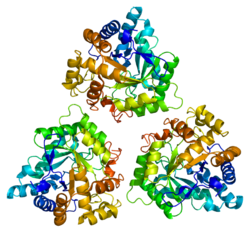3α-Hydroxysteroid dehydrogenase type 1 (3α-HSD1)[5][6][7] or aldo-keto reductase family 1 member C4 is an enzyme that in humans is encoded by the AKR1C4 gene.[8][9][10] It is known to be necessary for the synthesis of the endogenous neurosteroids allopregnanolone, THDOC, and 3α-androstanediol. It is also known to catalyze the reversible conversion of 3α-androstanediol (5α-androstane-3α,17β-diol) to dihydrotestosterone (DHT, 5α-androstan-17β-ol-3-one) and vice versa.[11]
Function
This gene encodes a member of the aldo/keto reductase superfamily, which consists of more than 40 known enzymes and proteins. These enzymes catalyze the conversion of aldehydes and ketones to their corresponding alcohols by utilizing NADH and/or NADPH as cofactors. The enzymes display overlapping but distinct substrate specificity. This enzyme catalyzes the bioreduction of chlordecone, a toxic organochlorine pesticide, to chlordecone alcohol in liver. This gene shares high sequence identity with three other gene members and is clustered with those three genes at 10p15-p14 on chromosome 10.[10]
Clinical significance
Various antidepressants, including the SSRIs fluoxetine, fluvoxamine, sertraline, and paroxetine, the SNRI venlafaxine, and mirtazapine, have been found to activate certain isoforms of the 3α-hydroxysteroid dehydrogenase, resulting in a selective facilitation of 5α-dihydroprogesterone conversion into allopregnanolone. This action has been implicated in their effectiveness in affective disorders, and has resulted in them being described as selective brain steroidogenic stimulants (SBSSs).[12][13][14]
Isozymes of aldo-keto reductase family 1 member C
| HGNC Gene Symbol | Enzyme Name Aliases[15] |
|---|---|
| AKR1C1 | aldo-keto reductase family 1 member C1; 20α-hydroxysteroid dehydrogenase |
| AKR1C2 | aldo-keto reductase family 1 member C2; 3α-hydroxysteroid dehydrogenase type 3 |
| AKR1C3 | aldo-keto reductase family 1 member C3; 3α-hydroxysteroid dehydrogenase type 2; 17β-hydroxysteroid dehydrogenase type 5; HSD17B5 |
| AKR1C4 | aldo-keto reductase family 1 member C4; 3α-hydroxysteroid dehydrogenase type 1 |
See also
References
External links
- Human AKR1C4 genome location and AKR1C4 gene details page in the UCSC Genome Browser.







